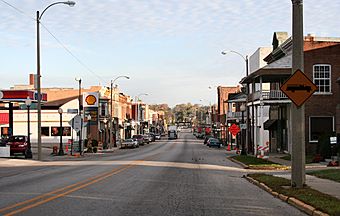Ligonier Historic District (Ligonier, Indiana) facts for kids
Quick facts for kids |
|
|
Ligonier Historic District
|
|

Downtown Ligonier, October 2005
|
|
| Location | Roughly bounded by Conrail right-of-way, Smith, Union, College, & Grand Sts., Ligonier, Indiana |
|---|---|
| Area | 146 acres (59 ha) |
| Architect | Multiple |
| Architectural style | Late 19th And 20th Century Revivals, Late Victorian, Bungalow/craftsman |
| NRHP reference No. | 87001798 |
| Added to NRHP | October 23, 1987 |
The Ligonier Historic District is a special area in Ligonier, Indiana. It is like a time capsule of buildings. This district is officially recognized as a national historic place. It is found in Noble County, Indiana.
This district includes 253 important buildings and two other items. These structures show how Ligonier grew between 1835 and 1937. You can see many cool building styles here. These include Italianate, Queen Anne, and Gothic Revival. There are also Classical Revival and Bungalow/Craftsman styles. Two famous buildings inside this district are the Ahavas Shalom Reform Temple and the Jacob Straus House.
Contents
Discovering Ligonier's Historic Past
The Ligonier Historic District holds many old and beautiful buildings. They show us what the town looked like long ago. This area developed over many years, from 1835 to 1937.
How Ligonier Town Began and Grew
Ligonier was first known as Perry's Prairie. White settlers arrived in this natural clearing in 1833. The town of Ligonier was officially planned in 1835. Another town, Rochester, was nearby on the Elkhart River. It was about 2 miles (3 km) southeast.
Ligonier was located on an important state road. This helped it grow faster than Rochester. In 1854, a railroad began to be built through the town. It was finished in 1857. This railroad brought many changes.
The town's street plan grew a lot because of the railroad. Ligonier's population more than doubled by the start of the American Civil War. Even more growth happened after the war. This was because the railroad connected Ligonier directly to big cities. These cities included Chicago and Toledo.
The Jewish Community's Important Role
By the late 1800s, the Jewish community became very important in Ligonier. Two traveling salesmen, Frederick William Straus and Solomon Mier, arrived in 1854. They came after the railroad was built. Both men became successful local business owners. They then started the town's two main banks.
Solomon Mier opened the Banking House of Solomon Mier in 1862. It later became the Mier Bank. Frederick Straus started the Citizens Bank in 1868. He did this with his brothers, Jacob and Mathias. More Jewish settlers came to northern Indiana. They arrived from German communities in Pennsylvania and Ohio. These communities also included Mennonites and Amish people.
By 1858, Jewish families were spread out in Noble and Dekalb counties. The community grew large enough to form a group. They called themselves Congregation Ahavas Shalom, meaning "Lovers of Peace." They first met in Auburn.
Ligonier was more welcoming to the Jewish community. They could take part in the town's social and political life. So, Congregation Ahavas Shalom soon began meeting in Jewish homes in Ligonier. Their first permanent building was a wooden structure, built in 1871.
By 1889, the Ahavas Shalom Temple was dedicated. It had about sixty Jewish families as members. This was about a quarter (27%) of Ligonier's population. Many of Ligonier's Jewish residents were merchants, bankers, and professionals.
Solomon Mier's banking business grew to Fort Wayne. It became the Citizens Trust Company. He also helped pay for trolley lines across Noble County. The Straus brothers started a brokerage business in 1860. It became the largest in the United States. They had offices in thirteen Midwestern states. The Straus brothers also opened banks in six states and Ontario, Canada.
Changes for the Community Over Time
As the Jewish community became successful, later generations moved. They went to larger cities like Chicago, South Bend, Fort Wayne, and Toledo. By 1904, the community in Ligonier was smaller. A rabbi traveled weekly from South Bend to support the temple.
By 1920, only twenty-four Jewish families lived in Ligonier. The Jewish Social Club closed in 1915. The B'nai B'rith Lodge, which started in 1878, closed in 1936. After 1932, services at the temple were only held on High Holy Days.



